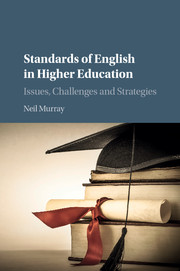Book contents
- Frontmatter
- Dedication
- Contents
- List of figures and tables
- Acknowledgements
- List of acronyms and abbreviations
- Introduction
- 1 The ‘English language question’ in the context of the changing face of higher education
- 2 English language: the need for and impact of policy and regulation
- 3 Seeking definitional clarity: what is ‘English language proficiency’?
- 4 Pre-enrolment language assessment and English language conditions of entry
- 5 Post-enrolment language assessment: challenges and opportunities
- 6 From assessment to provision
- 7 Innovation in English language provision: driving and navigating institutional change
- 8 Innovation in English language provision in higher education: an Australian case study
- References
- Appendices
- Index
7 - Innovation in English language provision: driving and navigating institutional change
Published online by Cambridge University Press: 05 November 2015
- Frontmatter
- Dedication
- Contents
- List of figures and tables
- Acknowledgements
- List of acronyms and abbreviations
- Introduction
- 1 The ‘English language question’ in the context of the changing face of higher education
- 2 English language: the need for and impact of policy and regulation
- 3 Seeking definitional clarity: what is ‘English language proficiency’?
- 4 Pre-enrolment language assessment and English language conditions of entry
- 5 Post-enrolment language assessment: challenges and opportunities
- 6 From assessment to provision
- 7 Innovation in English language provision: driving and navigating institutional change
- 8 Innovation in English language provision in higher education: an Australian case study
- References
- Appendices
- Index
Summary
The higher education sector as a particular context for innovation
While not all change necessarily amounts to innovation, and there are scholars who articulate differences between the two terms (e.g. De Lano, Riley and Crookes, 1994; Kennedy, 1999), in this chapter, and following Murray (2008), Wedell (2009) and Waters (2009), I use the words ‘innovation’ and ‘change’ synonymously.
Innovation is often cited as one of the hallmarks of good leadership (see, for example, Stoller, 2009) and, conversely, the lack of innovation as a ‘recipe for disaster’ (Goldsmith and Clutterbuck, 1984). White (1987) argues that, while it may be distasteful to some, ELT is an industry like any other, and thus Goldsmith and Clutterbuck's observation is as relevant to the ELT context as it is to other areas of industry. His argument reads as follows:
That ELT is an ‘industry’, let alone a mature one, may not appeal to teachers, who probably regard themselves as educationalists and not as industrialists. Yet, ELT is a service industry, supplying people with a service—English language teaching—and a commodity—the English language. So, although we may not be used to thinking in management terms, the effective running of any ELT enterprise is subject to essentially the same considerations as apply in any other industry.
(White, 1987, p. 211)While I would argue that it is legitimate to interpret White's reference to the ‘ELT industry’ as encompassing English language provision within higher education, it is the case that change within that context, and on the kind of institution-wide scale with which this book is concerned, raises a number of issues that would not necessarily arise with innovation in ELT on a more modest scale and within smaller organisations such as language schools. This is due, in part, to the unprecedented complexity of institutions of higher education today in terms of the following factors:
• The increase in regulation governing practices and the concomitant increase in institutional bureaucracy designed, in part, to guard against sanctions that can result from failure to comply. This is typified by the enormous bureaucracy surrounding UK universities’ efforts to ensure that they meet the UKVI requirements (see section 2.2.2). Such regulation and the potential dangers of failure to comply with stated good practice can have the effect of stifling innovation by reducing universities’ appetite for risk.
- Type
- Chapter
- Information
- Standards of English in Higher EducationIssues, Challenges and Strategies, pp. 178 - 200Publisher: Cambridge University PressPrint publication year: 2015

